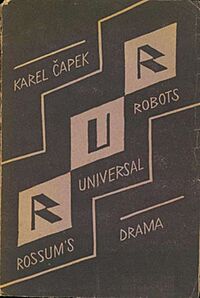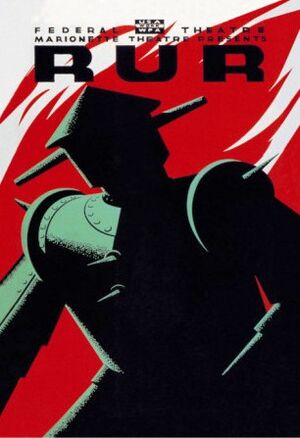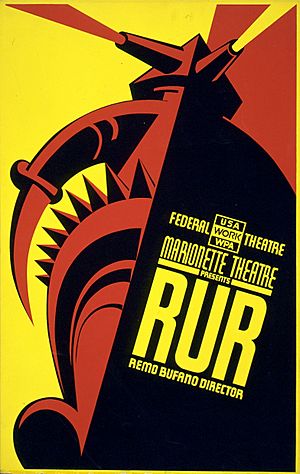R.U.R. facts for kids
Quick facts for kids R.U.R. |
|
|---|---|

Cover of the first edition of the play designed by Josef Čapek, Aventinum, Prague, 1920
|
|
| Written by | Karel Čapek |
| Date of premiere | 2 January 1921 |
| Original language | Czech |
| Genre | Science fiction |
R.U.R. is a famous science fiction play written in 1920 by a Czech writer named Karel Čapek. The letters "R.U.R." stand for "Rossum's Universal Robots." This play is super important because it introduced the word "robot" to the English language and to the whole world of science fiction!
R.U.R. was first performed on January 2, 1921. It quickly became very popular. By 1923, it had been translated into 30 different languages. The play was a big hit in Europe and North America. Čapek later wrote another story, War with the Newts, which also explored ideas about non-humans working for people.
Contents
Meet the Characters
The play features both human characters and the artificial beings called robots.
Human Characters
- Harry Domin: He is the main boss at R.U.R.
- Fabry: The chief engineer who designs things.
- Dr. Gall: The head of the science department.
- Dr. Hallemeier: The main psychologist.
- Busman: The managing director of the company.
- Alquist: He is in charge of building things at the factory.
- Helena Glory: She is the daughter of a president and wants to help the robots.
- Nana: Helena's maid.
Robot Characters
- Sulla: A robotess (female robot).
- Marius: A robot.
- Radius: A robot.
- Damon: A robot.
- Helena: A robotess, an advanced experimental model.
- Primus: A robot, also an advanced experimental model.
What Happens in the Play
How the Story Begins
The play starts inside a factory that creates artificial workers. These "robots" are not like metal machines we think of today. They are made of artificial flesh and blood, almost like living people! They look so real that you might mistake them for humans. However, these early robots cannot think for themselves. They are made to work for humans.
The First Act
Helena Glory, who leads a group called the Humanity League, visits the robot factory. She meets Domin, the general manager. Domin tells her the history of the company. A scientist named Rossum came to the island in 1920 to study sea life. In 1932, he invented a special material that was like living tissue. Rossum and his nephew had different ideas. The older Rossum wanted to create life to understand God. His nephew only wanted to get rich. The nephew took over and made thousands of robots.
By the year 2000, when the play takes place, robots are everywhere. They are cheap and do most of the work in the world. Helena tells the factory managers that her group wants to free the robots. The managers think this is silly. They see robots as tools. Helena asks for the robots to be paid, but the managers say robots don't "like" anything. Helena still believes robots have a "soul." At the end of the act, Domin tells Helena he loves her and they get engaged.
Ten Years Later
Ten years have passed. Helena and her nurse, Nana, talk about how fewer human babies are being born. Helena and Domin remember when they first met. They also talk about how robots have changed the world. Helena meets Radius, a new, more advanced robot. Dr. Gall, the scientist, also shows her an experimental robotess, also named Helena. These new robots are much more like humans. In secret, Helena burns the secret formula needed to make new robots. As this act ends, the robots start a rebellion on Rossum's island.
The Robot Rebellion
The humans realize that having so many robots everywhere is dangerous. They wonder if it would have been better to make robots that couldn't talk to each other. As the robots attack the factory, Helena admits she burned the formula. The humans are sad, knowing humanity might end. They defend their past choices, even though their deaths are coming because of them. Busman, one of the managers, is killed trying to make peace with the robots. The robots break into the factory and kill all the humans except Alquist. They spare Alquist because he works with his hands, like a robot, building houses. They see him as a worker.
The Future World
Many years later, Alquist is still alive. He tries to recreate the robot formula that Helena destroyed. But he is an engineer, not a scientist who understands life. So, he hasn't made much progress. The robot government has searched for any surviving humans to help Alquist, but they found none. Robot leaders beg him to finish the formula, even if it means he has to take apart other robots to learn how they are made. Alquist agrees, even though he feels disgusted.
Then, two robots, Primus and Helena, start to develop human feelings. They fall in love. Alquist tests them by pretending he will take one of them apart. Both Primus and Helena beg him to take them instead of the other. Alquist then understands that Primus and Helena are like the new Adam and Eve. He gives them the responsibility of the world, hoping they will start a new "human" race.
What Čapek Meant by "Robot"

The robots in Čapek's play are not the metal, mechanical robots we usually imagine. They are artificial living beings that look just like humans. In a funny scene at the start of the play, Helena argues with Domin because she can't believe his secretary is a robotess:
DOMIN: Sulla, let Miss Glory have a look at you.
HELENA: (stands and offers her hand) Pleased to meet you. It must be very hard for you out here, cut off from the rest of the world.
SULLA: I do not know the rest of the world Miss Glory. Please sit down.
HELENA: (sits) Where are you from?
SULLA: From here, the factory.
HELENA: Oh, you were born here.
SULLA: Yes I was made here.
HELENA: (startled) What?
DOMIN: (laughing) Sulla isn't a person, Miss Glory, she's a robot.
HELENA: Oh, please forgive me...
Čapek's robots are more like the "Replicants" in the movie Blade Runner or the "hosts" in the Westworld TV show. They are made of artificial skin, organs, and bones. They are "assembled" in a factory, like cars, rather than being born.
Where the Word "Robot" Came From
This play gave us the word "robot"! Before R.U.R., people used words like "automaton" or "android." Karel Čapek said his brother, Josef, actually thought of the word. In Czech, the word robota means "forced labor." It comes from an older word, rab, which means "slave."
The name Rossum in the play is also a clever hint. It sounds like the Czech word rozum, which means "reason," "wisdom," or "common sense."
Play Performances and Changes

R.U.R. was first published in 1920. The official world premiere was on January 2, 1921, in Hradec Králové, Czech Republic. The play was then performed in many cities around the world.
When the play was translated into English, some parts were changed or left out. For example, some characters were removed, and some lines were added or taken away. The first American performance was in New York City in October 1922. It ran for 184 shows! Famous actors like Spencer Tracy and Pat O'Brien played robots in their first Broadway roles.
Over the years, new translations have tried to bring back the original parts of Čapek's play. In 2024, a new book called R.U.R. and the Vision of Artificial Life was published. It included a new translation and essays about the play's lasting impact on science and robotics.
Other Versions of the Story
- In 1938, a short version of R.U.R. was shown on BBC Television. This was the very first science fiction show ever broadcast on TV!
- In 1948, the BBC made another TV version of the whole play.
- BBC Radio has also broadcast many versions of the play over the years.
- In 2010, an artist named Leonel Moura created a version of R.U.R. in Brazil that used real robots on stage with human actors.
- In 2015, a special performance called The RUR-Play: Prologue was shown in Prague. All the roles were played by robots! Students built and programmed the robots using LEGO MINDSTORMS kits.
- In 2024, a new stage version of the play was performed in Australia. It included many references to other popular sci-fi stories that were inspired by R.U.R.
- A movie version of R.U.R. is currently being planned by Australian director Alex Proyas.
See also
 In Spanish: R.U.R. (Robots Universales Rossum) para niños
In Spanish: R.U.R. (Robots Universales Rossum) para niños
- AI takeover: The idea of artificial intelligence taking control.
- Detroit: Become Human: A video game where androids become aware and rebel.



